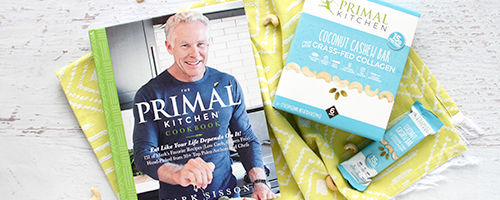Mark Sisson's Blog, page 179
June 18, 2017
Weekend Link Love – Edition 457
 RESEARCH OF THE WEEK
RESEARCH OF THE WEEKHigh cholesterol, lower Parkinson’s risk.
Cities are evolutionary hotspots.
19-year-olds are as sedentary as 60-year-olds.
Bariatric surgery creates an entirely new microbiome.
Many surgeries rely on the placebo effect.
Fried potato consumption raises mortality risk. Is it the potatoes, the frying, or the oil?
NEW PRIMAL BLUEPRINT PODCASTS
New Primal Blueprint Podcasts
Episode 173: Tero Isokaupilla: Host Elle Russ chats with Tero Isokaupilla, founder of Four Sigmatic and evangelist for medicinal mushrooms.
Each week, select Mark’s Daily Apple blog posts are prepared as Primal Blueprint Podcasts. Need to catch up on reading, but don’t have the time? Prefer to listen to articles while on the go? Check out the new blog post podcasts below, and subscribe to the Primal Blueprint Podcast here so you never miss an episode.
Cool Things You Notice Happening Once You Start to Lose Weight
ACES and Primal Health
Interesting Blog Posts
How the top Ultimate Frisbee athlete in America eats, trains, and lives.
Media, Schmedia
Between Rafe Kelley and Katy Bowman, the Pacific Northwest’s movement scene is quite strong.
Maine woman drowns rabid raccoon with her bare hands. Way to represent my home state.
Everything Else
“His parents didn’t think his condition was serious.”
Hugh Jackman sure does enjoy dancing.
The case for waiting to bathe newborns.
A man, his sword, and his dog.
Reason #1027 not to eat fast food.
Things I’m Up to and Interested In
Father’s Day giveaway contest you should jump on: The Primal Kitchen® Father-Daughter package, including signed copies of both my and Devyn’s new cookbooks, plus our full line of dressings, oils, and condiments.
New discovery I found fascinating: How memories form.
News I decided to misrepresent: Brazil is creating tilapia-human hybrids.
Important to read before you go swimming this summer: How much pee is in that pool?
I assume this happens daily in Brazil: Man drops groceries.
Recipe Corner
This bacon deviled egg salad might just replace my Big-Ass one on occasion.
Meat on a stick was good enough for Odysseus, it’s good enough for you.
Time Capsule
One year ago (Jun 18 – June 24)
Are Cell Phones and EMF Really Harming Your Health? – It’s complicated.
What is the Experience of Awe and Why Does It Matter? – Why you need to say “whoa” (and mean it).
Comment of the Week
“‘Man can’t live on bacon alone.’
The most horrific words ever spoken. ?”
– I know, Ontario. A few of my workers caught wind and tried prying my fingers off the keyboard. I almost wish they’d succeeded. So it goes.
And Happy Father’s Day to all the dads out there!

The post Weekend Link Love – Edition 457 appeared first on Mark's Daily Apple.



June 17, 2017
Coconut Marinated Short Ribs and Sautéed Kale
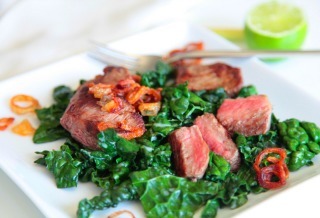 Boneless short ribs aren’t just for slow winter braises. Briefly thrown on the grill, boneless short ribs are also a delicious alternative to steak. The fatty marbling throughout keeps the ribs tender and flavorful. Grilled short ribs don’t necessarily need a marinade, but this one, made from coconut milk, lemongrass, ginger, garlic, fish sauce, and lime is a great one to try.
Boneless short ribs aren’t just for slow winter braises. Briefly thrown on the grill, boneless short ribs are also a delicious alternative to steak. The fatty marbling throughout keeps the ribs tender and flavorful. Grilled short ribs don’t necessarily need a marinade, but this one, made from coconut milk, lemongrass, ginger, garlic, fish sauce, and lime is a great one to try.
It’s no secret around here that coconut milk is a much loved, keto supportive healthy fat. Used as the base for a marinade, coconut milk gives meat an extra boost of fat and also adds flavor. It does the same for kale, adding richness and slight sweetness that tones down kale’s natural bitterness.
Coconut marinated short ribs and sautéed kale are best eaten hot, but both the leftover meat and kale will also satisfy as a cold lunch the next day.
Servings: 4
Time in the Kitchen: 1 hour, and at least 1+ hour for marinating
Ingredients

Short Ribs
2 pounds (907 G) boneless beef short ribs, cut into 8 to 10 pieces. If the pieces are more than 2-inches/50 mm thick, cut them horizontally into 1-inch/25 mm thick pieces.
1 stalk lemongrass
2 garlic cloves, chopped
1-inch piece peeled ginger, chopped (25 mm)
1 13.5 ounce can full-fat unsweetened coconut milk (divided between short ribs and kale) (400 ml)
2 tablespoons fish sauce (30 ml)
1 tablespoon fresh lime juice (15 ml)
Kale
2 bunches kale, leaves torn from stems and sliced or ripped into small pieces
1 tablespoon coconut oil (15 ml)
2 garlic cloves, finely chopped
1 red chile, thinly sliced, or 1/4 to ½ teaspoon red pepper flakes (2.5 ml)
2 shallots, sliced into thin rings
1 cup high-oleic sunflower oil, tallow, or lard (for frying) (240 ml)
Instructions

Remove tough outer layer of lemongrass. Bruise and flatten the stalk by crushing it with the flat side of knife. Cut the stalk into 3 or 4 pieces.
Combine lemongrass with garlic, ginger, 1 cup (240 ml) coconut milk, fish sauce and lime juice. Pour the marinade over the short ribs. Chill and marinate at least 1 hour and up to 12 hours.
While the ribs are marinating, fry the shallots for a garnish. In a small pot or saucepan, combine the sunflower oil, tallow or lard (or a combination of two) with the sliced shallots. Turn the heat up to medium. Cook until shallots are deeply browned (not burnt!), about 15 minutes. Stir occasionally, and turn the temperature up or down as needed as the shallots cook. Strain the oil from the crispy shallots. Set the shallots on a paper towel and set aside.
Pull short ribs out of the marinade and wipe off excess coconut milk.
Heat a clean and well-oiled grill to medium heat. Place short ribs on the grill. Don’t move for at least 4 minutes, and flip only when lightly charred. Once the short ribs are flipped, cook 8 to 10 minutes more, or until the internal temperature reaches 135 F (medium rare).
Take the short ribs off the grill and let sit for 10 minutes before slicing.
While the ribs are resting, sauté the kale. Heat coconut oil over medium heat in a wide skillet. Add garlic and hot pepper. Cook 1 minute, then add kale in handfuls, stirring and letting each handful wilt slightly before adding more. When all the kale is in the skillet, add the remaining coconut milk from the can. Cook a few minutes more until most of the coconut milk is absorbed. Add salt to taste.
Served sliced short ribs over kale. Garnish with fried shallots.

The post Coconut Marinated Short Ribs and Sautéed Kale appeared first on Mark's Daily Apple.



June 16, 2017
This Is Not a Story of Weight Loss, but of Health
It’s Friday, everyone! And that means another Primal Blueprint Real Life Story from a Mark’s Daily Apple reader. If you have your own success story and would like to share it with me and the Mark’s Daily Apple community please contact me here. I’ll continue to publish these each Friday as long as they keep coming in. Thank you for reading!

This is not a story of weight loss (I’ve always been thin), but of health. I grew up on a diet of ramen noodles, pasta, potato chips, pizza rolls, and Dr. Pepper. So it’s no surprise that I was diagnosed with an autoimmune disease by the time I was 19.
When I was a teenager, nutrition consisted of reading prevention magazine for tips on “heart healthy whole grains”. My first real step towards health was when I was about 14 and decided to give up soda for my New Year resolution. It was HARD. My family thought I was strange when I got water instead at a fast food restaurant, especially since the soda was “already paid for” with my meal. But I did it. Of course, that wasn’t the end all cure for my health problems. I had a lot further to go.
When I was about 13 the health issues I’d been dealing with all my life got worse. Constipation, inability to tolerate heat, canker sores, fatigue, etc. If we went out shopping, I couldn’t stand or walk for more than about an hour without having to sit down. My mom took me to the doctor and had some tests run. Negative for thyroid problems. If only I’d known how wrong that doctor was.

When I was about 15, I started having issues with my heart racing. I would be at school, sitting at the computer, and suddenly I could FEEL my pulse in my neck. I tried to describe it to my doctor but he didn’t understand what I meant. Still, I was given an EKG (small murmur but nothing too out of the ordinary) and a heart monitor, but I was never able to catch an episode and record it.
Around this time I somehow got my hands on It Starts With Food, read it voraciously, and started a Whole 30. I lasted a day before the carb flu was too much and I quit. “See,” people said, “this is just proof that you need some carbs and grains in your diet!” I continued to eat junk for the next 4 years of my life, but I also began to read websites on paleo and primal diets (including Marks Daily Apple) and make small improvements here and there.
Finally, when I was 19 (2012), I went to a normal yearly check up. As my doctor was feeling my throat she told me my thyroid felt enlarged, and she was going to order some blood tests. What I didn’t know at the time was that I was extremely fortunate, because my doctor had an autoimmune thyroid disease called Hashimoto’s. And because she had this disease, she knew not to just test my TSH, and maybe my T4, like most doctors do. She also tested my antibodies. The results came back and it was confirmed: I had Hashimoto’s. Those racing heart issues? Caused by hyperthyroidism as my body was destroying my thyroid. Finally, an answer to what was wrong with me.
She immediately put me on levothyroxine, which did temporarily help me feel better. But I also decided to take my diet more seriously. I reread It Starts With Food and devoured The Primal Blueprint. I began to eat even more paleo, although not yet 100%, and I saw improvements. That summer I gave the Whole 30 another try and it changed my life. Constipation, gone. Canker sores, gone. Fatigue, not gone but much improved. That summer I went kayaking in the Austin heat (100+ temperatures) for hours and didn’t suffer from heat exhaustion like I normally would. I got my antibodies tested again, and they were so low that if I had not tested them before, you wouldn’t know I had an autoimmune disease.
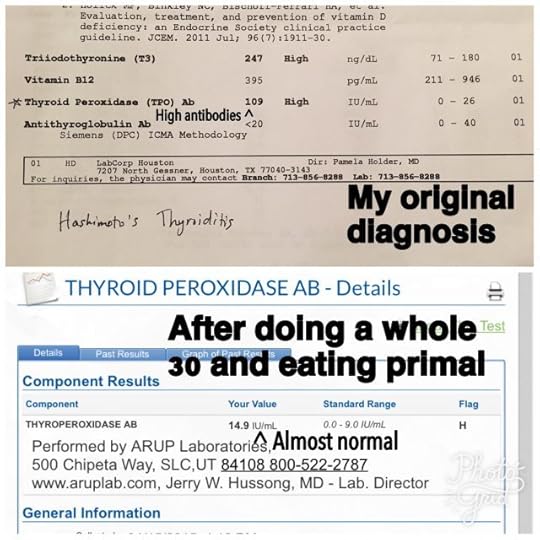
I began following a mostly primal diet, and reading the Marks Daily Apple success stories every week for inspiration. Every once in awhile I’ll do another Whole 30 or the Primal challenge to reset my diet. But that was not the end of my primal journey.
A few months ago I cheated on my diet a lot and ate way more gluten than normal. I’d long suspected that gluten was to blame for my canker sores, and when they came back with a vengeance it all but confirmed it for me. I did some research and learned that canker sores are actually a symptom of celiac disease. I also learned that once you have one autoimmune disease it’s very common to develop another, and Hashimoto’s and Celiac especially go hand in hand. I went to see a gastroenterologist to see about getting tested for celiac but learned that to be diagnosed you have to eat gluten for at least a MONTH beforehand. This is because the only way to test is to look for the damage that the disease causes to your body. There was no way I was going to put myself through that and undo my hard work, so I didn’t go through with the test. However, I did get some genetic testing done to see if it is possible for me to have celiac. You can’t be diagnosed from a genetic test, because there are a lot of factors that go into whether or not a gene is expressed. I found out that not only do I have one of the genes associated with celiac disease, but I also have all six genotypes that increase the likelihood that you will develop celiac disease. All this confirmed for me is that I am on the right path, and avoiding gluten forever 
June 15, 2017
Announcing The Primal Kitchen Cookbook!
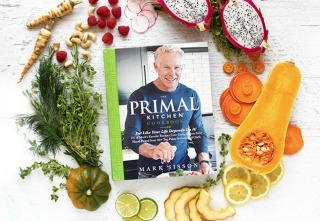 Two years ago in 2015, I founded Primal Kitchen® because I had a vision—a vision that extended the nutrition philosophy I’d honed with the help of this blog for (then) nearly decade. I wanted to make truly healthy—Primal—eating easier and more convenient. I wanted to create the kinds of products that I would use in my own kitchen—and offer them to others with the same health goals and the same love of amazing food.
Two years ago in 2015, I founded Primal Kitchen® because I had a vision—a vision that extended the nutrition philosophy I’d honed with the help of this blog for (then) nearly decade. I wanted to make truly healthy—Primal—eating easier and more convenient. I wanted to create the kinds of products that I would use in my own kitchen—and offer them to others with the same health goals and the same love of amazing food.
Since then, I’ve introduced more than a dozen products that do just that—some of them (I’m very proud to say) award-winning. And I’ve had a tremendous team behind this vision the whole time, helping me offer the very best in taste and nutrition—and doing the work of making Primal Kitchen choices available literally nationwide. Today I get to announce a project that’s evolved within that Primal Kitchen endeavor—an incredible collaboration among my remarkable staff, long-time friends, and even my own children: The Primal Kitchen Cookbook.
In this collection, you’ll find recipes from more than 50 chefs, authors, and innovators within the Primal, paleo, and wellness communities (including a few from yours truly). It’s too many to list here, but—trust me—they’re all the best of the best, including Melissa Hartwig, Robb Wolf, Chris Kresser, Sarah Fragoso, Tony Horton, Laird Hamilton, Cassy Joy Garcia, Kelly Brozyna, Mary Shenouda, and many more. I’m grateful to every one of them for offering their talent to this project.
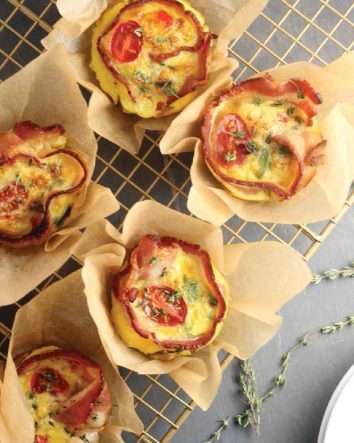 In the back of the book, there’s a full biography section so you can get to know each contributor and the websites and publications where you can connect with them further. I hope the list opens new doors for you. I swear, I’ve never been so inspired by a book’s appendix….
In the back of the book, there’s a full biography section so you can get to know each contributor and the websites and publications where you can connect with them further. I hope the list opens new doors for you. I swear, I’ve never been so inspired by a book’s appendix….
But let’s get to the real meat of the book, shall we—the 131 extraordinary recipes themselves. Here’s where it’s at, folks. I’m talking big breakfasts, Primal Kitchen Restaurant featured smoothies, nutrient-dense salads and lunches, succulent dinner entrees, rich desserts, tempting small bites, and various sauces and dressings.
I’d take up your entire day if I talked about all of the recipes and what I love about them, but let me throw just a few highlights out there….
Chia Vanilla Swirl Smoothie
Protein Pancakes
Fennel and Olive Omelet
Thin Mint Smoothie
Coconut-Crusted Shrimp Fresh Garden Salad
Prosciutto Mango Collard Wraps
BBQ Chicken Dip
Chipotle Bacon Deviled Eggs
Marinated Filet Mignons
Bison Chili
Lamb Burgers with Pistachio Pesto
Dark Chocolate Almond Granola
Cheesecake Power Bites
and much MORE…
Anyone ready to eat yet…?
Each recipe offers a macronutrient assessment and is labeled for specific dietary interests, including Autoimmune Protocol, dairy free, ketogentic, no sugar added, vegan, and Whole30®. All are low carb, gluten free, and hand-picked from my favorites. Want motivation for your Primal eating? These recipes deliver, no matter what your dietary interest or personal taste.
Check it out….
Now for the Deal…
Per Mark’s Daily Apple tradition, I’m offering my MDA readers a special deal on The Primal Kitchen Cookbook unavailable anywhere else.
I’ve personally signed 500 books for those first 500 orders, and for all PrimalBlueprint.com purchases, I’m throwing in a FREE box of PRIMAL KITCHEN® Coconut Cashew Bars. One deal per person.
Just use the code PKCOOKBOOK at checkout. But hurry! This deal is done June 21st at midnight PDT.
For those who would prefer to purchase on Amazon, know that the book is ready and available there, too, but the MDA deal applies to PrimalBlueprint.com orders only. Be sure to leave a review (on either/both Amazon and PB.com) if you like the book!
That’s it, folks. I’m so excited for this one—for my staff and for all the friends of MDA and Primal Kitchen who contributed (as well as their fans). I love the Primal paleo community, and this cookbook reflects the amazing spirit of collaboration and the unmatched commitment to genuine thriving that this community is built on. Thanks for reading today and for all your support over the years, everybody. Let me know what you think!
The post Announcing The Primal Kitchen Cookbook! appeared first on Mark's Daily Apple.



June 14, 2017
My 16 Favorite Fat Sources (Plus My Latest Big-Ass Salad)
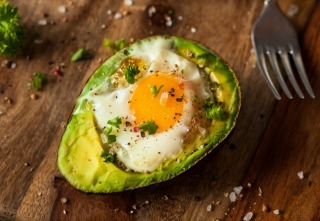 Going ketogenic has made me hone in on my fat sources even more than before. This is an essential practice for anyone seriously pursuing a ketogenic diet. As fat will comprise the majority of your calories, you need to maximize the nutrition you’ll obtain from the fats you choose. You could technically go keto using canola oil, refined coconut oil, and MCT oil powder—many of the ketogenic formulas used in epilepsy clinics are highly processed and refined—but I wouldn’t recommend it. Micronutrients still matter. They arguably matter even more when your food sources are restricted.
Going ketogenic has made me hone in on my fat sources even more than before. This is an essential practice for anyone seriously pursuing a ketogenic diet. As fat will comprise the majority of your calories, you need to maximize the nutrition you’ll obtain from the fats you choose. You could technically go keto using canola oil, refined coconut oil, and MCT oil powder—many of the ketogenic formulas used in epilepsy clinics are highly processed and refined—but I wouldn’t recommend it. Micronutrients still matter. They arguably matter even more when your food sources are restricted.
I try to get whole food fats. If the fat is isolated and extracted, I try to make sure it’s rich in micronutrients. If it’s low in micronutrients, I make sure I have a good reason to consume it.
There are many reasons. Some rooted more in nutrition, some more in pleasure, some convenience.
So what are my favorite fat sources? How do I use them? What do I find so appealing?
Extra Virgin Olive Oil
From the historical precedent (1000s of years of heavy use in the Mediterranean and Levant), the clinical support (hundreds of trials showing beneficial effects), and the light peppery finish, it’s difficult for anyone to deny the beauty and enduring utility of a good bottle of extra virgin olive oil. I’ll. Even though EVOO is quite robust in the face of high heat, I still prefer using it in certain dressings and for lightly grilling fish, just to preserve the delicate flavor.
Go to a farmer’s market and buy the local olive oil that tastes best to you. Absent that, the EVOOs from California are usually quite good (and real).
Extra Virgin Avocado Oil
I rifled through dozens of avocado producers to find the perfect source of extra virgin avocado oil so that I could sell the best product, sure, but also because I wanted the best for myself. That’s ultimately how I come up with any of my projects and businesses—to scratch my own itches. It seems to be working, because I haven’t had a tastier oil that asserts itself without losing its capacity to work with other foods. EVOO doesn’t work with everything. EVAO, in my experience, does.
This one’s quite good. And all our Primal Kitchen dressings are made with avocado oil.
Coconut Milk in Smoothies and Curries
In powder form, coconut milk creates the creamiest, smoothest protein (whether whey or collagen) powder I’ve ever tasted, which is why I added it to Primal Fuel and Collagen Fuel. Plus, it’s a great source of medium chain triglycerides, special fatty acids that convert directly into ketones.
The fact that it’s a traditional fat used by many successful Pacific Islander cultures, sometimes in copious amounts, without any indication of poor health consequences is another mark in its favor.
I like Aroy-D in the small cartons.
Egg Yolks
Gram for gram, egg yolks are the most nutrient-dense fat around. And they’re not just something you scramble. They’re legitimate culinary fats. No, you won’t sauté your veggies in egg yolk. That wouldn’t work. Egg yolks can provide the backbone of a salad dressing, like classic Caesar or one of my personal favorites (yolks, sesame oil, minced garlic, lemon juice, kosher salt, pepper, and a little avocado oil to round it out). You can drop them whole into sauces right after you turn off the heat to thicken. They blend well into smoothies and hot coffee.
Go for local pastured eggs if you can get them. If not, many grocery stores are starting to offer very good pastured eggs, and not just the health food stores. Vital Farms pastured eggs are very good and available pretty much everywhere, like Target and major grocery stores.
Emmental Cheese
Maybe next year it’s aged gouda. And the year after that, pecorino romano. but right now, I’m really digging Emmental cheese. If you haven’t had it, Emmental is a medium-hard Swiss-style cheese. It’s not intense like an aged gouda. It’s nutty and mild, so you have to really listen to the flavors to extract the most pleasure.
True Emmental comes from raw, grass-fed cow milk. Look for that kind.
It’s also my current favorite on my latest version of my Big-Ass (Keto) Salad. Emmental, along with avocado and avocado oil-based Caesar dressing, is in part what makes me call it my “fat bomb” salad. As most of you know, my Big Ass Salad has always been the centerpiece to my day, but it’s even more important now. It’s become a crucial vehicle for the delivery of my daily fat intake during my keto stretches. If you haven’t already, go check out my new and improved Big-Ass Keto Salad. Try it, and let me know what you think.
Avocado
Slice it, smash it, spread it, Jeb it, even grill it. Avocado is the greatest. Even though I have ample access to all the avocado oil and avocado oil-based mayos and dressings I want, I still return to the humble avocado. Maybe it’s because I like the fiber and potassium. Maybe it’s because I like reducing the inflammatory load of my meals.
California hass all the way.
Grass-Fed Butter
These days, I mostly use grass-fed butter on any steamed veggie that enters my mouth. Broccoli, spinach, kale, cauliflower, and dozens more. I’ll also dip shrimp in melted butter.
Kerrygold is a stalwart and available almost everywhere.
Bacon Fat for Sautéing Veggies and Frying Eggs
Man can’t live on bacon alone. It’s just not feasible or advisable to obtain the bulk of your calories from bacon strips. But if you keep some bacon fat around for sautéing veggies and frying eggs, you’ll always have that hint of bacon. Now, some caveats. I cook my bacon slow over low heat, which reduces oxidative damage to the fats. My bacon comes from pigs fed oats and barley, which creates a more oxidatively-stable fatty acid profile (higher in MUFAs, lower in PUFAs) and imbues the fat with more actual antioxidants. Don’t know what the pigs ate? The harder/firmer the raw bacon, the more saturated/monounsaturated/stable it’ll be.
Aim for pastured and/or firm bacon.
Ghee
I err on the side of tradition, usually. And if I’m making an Indian curry or sautéing some okra with mustard seed, turmeric, and ginger, I stick with ghee. That’s what these recipes were “meant” to include, and it tastes great. Ghee’s also a good option for high heat searing, since the proteins and lactose (which burn) have been completely removed.
I love the brown butter ghee from Tin Star.
Red Palm Oil
If I’m eating starch, I’ll often turn to red palm oil. A couple of red potatoes, baked, smashed (skin on), then doused with red palm oil, sprinkled with crunchy salt and a ton of cracked black pepper? Almost no one in the history of the world has eaten this, let alone eats this on a regular basis, but it’s really good. It’s also quite good on butternut squash (less starchy than potatoes) with turmeric, salt, and black pepper. (Both versions are strictly for my non-keto days.)
As for African dishes, I’m far from an expert. What seems to work is sautéing garlic, onions, tomatoes, and ginger in red palm oil, then adding some protein (chicken or fish, usually), and stirring in a nut butter and perhaps some hot pepper toward the end.
Best stuff I’ve had came from a random West African market, sold in mason jars marked only with the country of origin. The redder the better. Good to look for sustainable sourcing, too. If you don’t have any of those nearby, this one’s good too.
Mac Nut Butter
I’ll eat other nuts, like Brazils (selenium) and almonds (magnesium), but I don’t consider them to be fat sources. They’re certainly rich in fat. They just have other macronutrients, too. Mac nuts are basically pure fat. Mac nut butter, if it comes from really good mac nuts (and there can be some duds), is
June 13, 2017
Cool Things You Notice Happening Once You Start to Lose Weight
 Most people come to the Primal Blueprint because they want to lose weight. Ask any purveyor of a specific diet and they’ll say much the same thing. The majority of people are interested in dropping body fat, looking good naked, and fitting into their clothes. The interest in overall health, fitness, and lifestyle tends to develop organically out of that. Come for the weight loss, stay for the blue-blocking goggles.
Most people come to the Primal Blueprint because they want to lose weight. Ask any purveyor of a specific diet and they’ll say much the same thing. The majority of people are interested in dropping body fat, looking good naked, and fitting into their clothes. The interest in overall health, fitness, and lifestyle tends to develop organically out of that. Come for the weight loss, stay for the blue-blocking goggles.
There’s a tendency to view weight loss as superficial compared to the other stuff. That’s a mistake. Weight loss isn’t just about belt notches and positive experiences with mirrors. It confers measurable and, most importantly, tangible benefits to health, happiness, and daily functionality almost immediately. Fat loss, it turns out, isn’t a flighty pursuit. It solves a lot of serious problems and makes some really cool things happen.
Like what?
Your Joints Stop Hurting So Much
Crippling osteoarthritis is relatively rare, but almost everyone has a joint that creaks, pops, aches, or occasionally flares up in pain. Weight loss improves that pain by reducing the forces acting on the joints when you walk (though increasing your walking speed attenuates this, somewhat), with each lost pound reducing forces acting on the knee joint by a factor of four. Patients with psoriatic arthritis who lose weight report less inflammation and more activity; same goes for osteoarthritis patients. All that said, people with joint hypermobility may experience increased pain with weight loss.
You’re Not So Hungry (Hopefully)
This one depends on the manner in which you lose weight. If you’re starving yourself, forcing a low-fat, high-carb diet, willing yourself to reduce calories despite your physiology clamoring for more food, you’ll be hungry—maybe hungrier than you can even handle. If you go Primal on the other hand—higher fat, lower carb, plenty of protein, a focus on nutrient density—you probably won’t be very hungry. You’ll become fat-adapted, which lets you coast effortlessly for hours between meals. Instead of snacking on whatever garbage they put out in the office, you snack on your adipose tissue.
You Sleep Better
Weight loss seems to improve sleep quality, whether it’s from diet alone or exercise and diet, especially if the weight comes off the belly. Even moderate weight loss remains the best treatment (and preventive measure) for sleep apnea, in many cases outright curing it.
Exercise Suddenly Appeals to You
That’s the real secret about exercise and weight loss: The relationship is reversed. While the right kinds of exercise can certainly make fat loss more effective and help you retain lean mass during dieting, most people are surprised to discover that losing weight makes them want to move. One reason is that a lighter body makes movement less onerous. You can do more things without those extra 40 pounds. You can climb higher, hike longer, do more pullups and pushups, jump farther, run faster. Physical exertion is more fun and rewarding when you’re not lugging around extra weight. As we all know, intrinsic reward makes you more likely to stick to a workout plan.
Your Groove Returns
There are many reasons why being overweight or obese impairs the libido. You lose self-confidence. You feel less attractive than you used to. There may even be logistical difficulties. And on a physiological level, the biological mechanisms that make sex happen don’t work as well when you’re overweight or obese. Testosterone (which affects libido in both men and women) plummets. Endothelial function suffers, impairing necessary blood flow to certain erogenous regions of the body. When you start losing weight, your sex hormones normalize. Blood flows once again. Your libido returns. And let’s be blunt here. You’ll feel lustier (and attract it in return) when you’re at a healthier body weight—not “skinny,” but healthy.
You Think More Clearly
Obese adults with mild cognitive impairment who lose weight enjoy better cognitive function. This may not hold true in all situations. College wrestlers who drop weight quickly, for example, suffer (temporary) cognitive impairments (mood and memory), and older adults who lose weight in the later years are at a greater risk for mild cognitive impairment; in that population, weight loss tracks with Alzheimer’s progression. I suspect these older adults developing Alzheimer’s are losing more lean mass than fat mass. By and large, studies show that fat loss improves your brain health.
You Have More Energy
You’re suddenly tapping into a virtually inexhaustible reservoir of energy—your own body fat. When your insulin is controlled, and you can release and burn fat as needed, your energy levels are remarkably consistent. If you’re losing body fat, you’re burning body fat for energy, and it’s a nice clean burn. The steady release of energy you experience with fat loss is a far superior experience to the ups-and-downs of regular glucose infusions.
You’re More Productive
Studies show, with some equivocation, that weight loss improves employee productivity. Part of this is psychological. You look better, feel healthier, and that overall improved mood translates into more confidence and better output at work. But it’s also physiological. You’re sleeping better. You have more energy. You think more clearly.
Your Doctor’s Visits Go More Smoothly
Research consistently shows that weight loss improves biomarkers across the board. You may not feel your blood pressure improving, your LDL becoming less oxidized, the dimming of your inflammatory status, or the large number of HDL particles coursing through your veins, but you’ll notice your health markers improving on lab tests and doctor visits.
You might notice a common thread running through all these changes: Many of them both perpetuate and are perpetuated by weight loss. You lose weight, and exercise is more fun and your joints don’t hurt as much, so you exercise more, and lose more fat and gain more muscle. You lose weight and suddenly your sex life improves, so you stop satisfying your pleasure centers with junk food, and you lose even more fat. Better sleep begets a lower desire for junk food, better insulin sensitivity, and faster workout recovery, allowing further fat loss.
Fat loss gets the ball rolling. Everything begins improving downstream of those first few pounds lost. Losing weight makes all the other positive changes to your healthy lifestyle easier, more effective, and more sustainable.
What are your favorite “side” symptoms of losing weight? What benefits weren’t mentioned in today’s article? Let me know down below.
Thanks for reading, everyone. Take care.
The post Cool Things You Notice Happening Once You Start to Lose Weight appeared first on Mark's Daily Apple.



June 12, 2017
Dear Mark: Keto Follow-Up
 For today’s edition of Dear Mark, I’m answering some questions from the comment board of last week’s Definitive Guide to Keto. You folks came up with some great ones. Is counting carbs in non-starchy vegetables still unnecessary on a ketogenic diet? What’s the connection between ketosis and “starvation mode,” and should we be worried? What if you don’t want to lose weight on a ketogenic diet—what modifications should you make? Are you in danger of blowing a breathalyzer test due to ketone metabolites on your breath? Can endurance athletes benefit from keto? Is cyclical ketosis preferable to constant ketosis? Are sugar alcohols ketogenic-friendly?
For today’s edition of Dear Mark, I’m answering some questions from the comment board of last week’s Definitive Guide to Keto. You folks came up with some great ones. Is counting carbs in non-starchy vegetables still unnecessary on a ketogenic diet? What’s the connection between ketosis and “starvation mode,” and should we be worried? What if you don’t want to lose weight on a ketogenic diet—what modifications should you make? Are you in danger of blowing a breathalyzer test due to ketone metabolites on your breath? Can endurance athletes benefit from keto? Is cyclical ketosis preferable to constant ketosis? Are sugar alcohols ketogenic-friendly?
Let’s go:
I got a very important question. In terms of standard, not ketogenic, low/moderate carb diets I’ve read where you shouldn’t count low calorie green veggies considering most of their glucose is burned during the digestion process. This method has worked for me very well, when I count carbs I think of fruits, tubers, berries, honey, etc., not broccoli and kale. But if I were wanting to experiment with ketosis should I count broccoli, kale, spinach, and other green veggies? Or does the same method apply in ketosis?
— Jackson
It applies to ketogenic diets, too. You can still eat non-starchy vegetables freely. One way to think of it is that vegetables that grow above the ground are safe while vegetables that grow beneath the ground can knock you out of ketosis.
Some might say, “What’s the harm in counting?” After all, you’re only being accurate. A diet should be as effortless as possible. You want to remove as much unnecessary stress as you can, and counting the carbs in broccoli is about the silliest thing to stress over.
Never heard of this diet before Its very interesting what got me confused was that I have always read that making your body in a ”starving feel” if i’m understanding right it’s basically the purpose of this diet your body lowers your metabolism as your body is scared that there is no food. But this diet is saying it helps you lose weight which contradicts with what i just said. I am no nutrition expert by all means if anyone could explain to me if what I said is basically a myth or why this diet works different I would be really grateful heck il even give it a try and see how it goes haha :3
— Pineapple Deficiency
A ketogenic diet tries to mimic the beneficial effects of starvation while limiting the negative effects. Ketones mimic the life-extending effects of caloric restriction, for example. Ketosis also induces autophagy, just like fasting. But because there are still ample micronutrients coming in, and you’re eating enough protein to provide the amino acids you require from meat (rather than your own muscle and organ tissue), most of the negative effects are reduced.
Thank you for this information. For many of the health benefits you list, I’d like to get into ketosis for a time. But I do NOT want to lose weight. I don’t have any pounds to spare. The past couple of times I’ve tried this diet it was hard for me to maintain my weight. I have no fear of healthy fats like lard, butter, heavy cream, etc, but it was still hard to eat enough. Any advice for us skinny guys and gals who want to get into ketosis without losing weight?
— Robert
Ah, yes. What is an important feature of the ketogenic diet for most people—the inadvertent reduction in calories—is a flaw for you. You have a few options.
Give up on “deep” ketosis. Eating slightly more carbs and protein will reduce—but not abolish—ketone production and allow you to eat more calories to maintain weight. For most people, deep ketosis is unnecessary and unnecessarily restrictive.
Eat a bit more protein. As long as you’re training, you can handle a bit more protein than you think and remain ketogenic. Some people find protein to be even more satiating than fat, so this could make eating more calories harder, not easier.
Try ketone supplementation. Supplemental ketones take effect regardless of diet composition.
Try MCT oil. MCT oil increases ketone production, even on top of a high-carb intake. This allows you to eat a less restrictive diet (higher in protein and/or carbs) while still making ketones. I have my reservations about whether forcing ketone production on a high-carb diet is a good long-term strategy, but it’s possible.
Fast. Get in a good 24-hour fast once a week or so. You’ll slip into ketosis during your fast, and eat normally the rest of the time. This probably won’t build the fat-burning metabolic machinery like three or four weeks of ketosis will, but it’s a compromise.
I’ve had great results going keto, but one thing concerns me: I’ve heard that ketogenic diets can cause false positives on drunk driving breathalyzers. Anyone have any information on this?
— anonymous
It’s possible. A case study showed that alcohol dehydrogenase (an enzyme that metabolizes ethanol) can convert the acetone you’ve built up from ketosis into isopropanol—one of the metabolites breathalyzers test for.
OK, I’ll do it. I’ll be more strict about the Primal Blueprint until July 4th, then try keto for six weeks. I am training for the Chicago Marathon on October 8th, though. Is there a conflict between keto and endurance training?
— Ion Freeman
Check out my last book, Primal Endurance, for more details.
But long story short: Yes, endurance athletes can benefit from going keto. They don’t have to stay ketogenic.
Ultra-endurance athletes seem better suited for full-time keto. The biggest strides in ketogenic performance are happening in ultramarathons and other long-distance events.
But marathoners can benefit from keto-adaptation, even if they don’t stay there full-time. You have till October, plenty of time to get fully keto-adapted, build the metabolic machinery in your muscle mitochondria to get really good at burning free fatty acids, and then return to a diet with more (but not necessarily high) carbs. Make sure to cycle in some ketogenic bouts, just to keep your capacities topped off.
If you do this correctly, you’ll be great at burning fat and glucose by the time the marathon rolls around. You’ll burn more free fatty acids and less glycogen at the same intensity, leaving you more glycogen for the last legs of the race.
You’ve touched on it before and here again but for most who do not *need* keto do you encourage cyclical ketosis as in not 24/7/365. In my opinion and experience and just thinking from an evolutionary and physiologic (maintain insulin sensitivity and reduce physiological insulin resistance of keto, gut microniome, nutrients) standpoint it makes sense that most would benefit from non constant ketosis. Any thoughts?
— Marissa
That’s my basic stance.
Few people “need” to be fully ktogenic all the time.
Everyone “should” be ketogenic some of the time.
I do maintain that everyone should try three to six weeks of ketogenic eating, if only to see what it feels like, observe how their body responds, and build the metabolic machinery in the muscles necessary to burn free fatty acids en masse.
Do sugar alcohols in sugar free gum affect ketosis!? I sometimes chew a lot of gum while at work and worried it may be affecting my body going into Keto: thank you for any insights.
— Fitforme
Erythritol and xylitol shouldn’t have an effect. Eat freely, as long as they don’t upset your stomach.
Avoid maltitol. It contains digestible carbs (about 2-3 calories per gram, compared to 4 calories per gram of glucose). On the plus side, maltitol is a great long-lasting laxative. Just be sure to set aside 2-3 days for the journey.
That’s it for today, folks. If I didn’t get to your question here, I’ll revisit the comment board for more follow-up info in the coming weeks.
Thanks for reading. Take care.
The post Dear Mark: Keto Follow-Up appeared first on Mark's Daily Apple.



June 11, 2017
Weekend Link Love – Edition 456
 RESEARCH OF THE WEEK
RESEARCH OF THE WEEKModerate drinking emerges as a risk factor for cognitive decline.
We’re not even close to understanding the biological control of appetite.
If you’re going to take milk protein after lifting, 9 grams is the absolute minimum (and more is better).
New drugs are being fast-tracked without adequate testing.
Fetuses in the womb respond to face-like images.
Short, high-intensity resistance training improves pancreatic function in type 2 diabetics.
Teen girls are really depressed.
NEW PRIMAL BLUEPRINT PODCASTS

Episode 172: Marla Sarris: Host Elle Russ chats with Marla Sarris, co-founder of PaleoPorn (not like that), brand development expert, documentary producer, and co-creator of the Week of Zen meditation course. Busy lady.
Each week, select Mark’s Daily Apple blog posts are prepared as Primal Blueprint Podcasts. Need to catch up on reading, but don’t have the time? Prefer to listen to articles while on the go? Check out the new blog post podcasts below, and subscribe to the Primal Blueprint Podcast here so you never miss an episode.
INTERESTING BLOG POSTS
With age comes wisdom (really).
It might be time to admit that we don’t have a very solid grasp on the evolutionary story of modern humans.
Early hominids could really take a punch.
MEDIA, SCHMEDIA
Silicon Valley techies are really into extended fasting.
The Amazon extras in Wonder Woman were pretty much all elite female athletes.
EVERYTHING ELSE
Next we’ll be decoding dreams.
This sounds like a book I need to read.
THINGS I’M UP TO AND INTERESTED IN
Video I recommend: The outer limits of human survival.
Podcast I appeared on: Wellness Force, where I spoke about Primal living in the modern world, the power of intuition, the myth of “good” and “bad” genes, and much more.
Concept I’m pondering: The aging identity.
Article I loved: How visionary biologist George Church parlayed narcolepsy into creative genius.
News I enjoyed: Ivory Coast jails chimpanzee traffickers for the first time ever.
RECIPE CORNER
This paleo jibarito sandwich doesn’t have any bread.
These tacos don’t have any tortillas.
TIME CAPSULE
One year ago (Jun 11 –June 17)
How Defining Moderation Can Help You Reach Your Health Goals – Why your idea of “moderate” needs a moderator.
Top 8 Changes Coming to Nutrition Labels – What changes are coming?
COMMENT OF THE WEEK
“Are chic peas like chick peas, just more fashionable?”
– Well done, Ross.

The post Weekend Link Love – Edition 456 appeared first on Mark's Daily Apple.



June 10, 2017
Adaptogenic Keto Fat Bombs
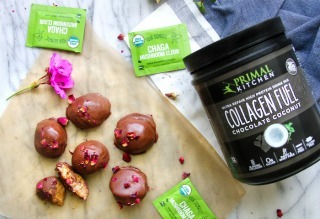 The basic ketogenic diet garners about 65-75% energy needs from fat sources. While a good Primal diet offers much in the way of healthy, varied fats, with keto it’s helpful to have extra strategies for incorporating additional good fats. That’s where the keto fat bomb comes in.
The basic ketogenic diet garners about 65-75% energy needs from fat sources. While a good Primal diet offers much in the way of healthy, varied fats, with keto it’s helpful to have extra strategies for incorporating additional good fats. That’s where the keto fat bomb comes in.
But that doesn’t mean shoring yourself up for anything tasteless or unappealing. Many fat bomb recipes—like this one—aren’t even savory. In fact, with just enough sweetness, the prevailing taste of this keto fat bomb is rich, cocoa goodness—deepened by an earthy nuance of chaga mushroom mix.
And here’s what makes these particular fat bombs so special. Not only do you gain all the major benefits of collagen and a healthy dose of nutrient-dense fat from coconut oil and almond butter, you’ll also get the nutritional magic of adaptogenic chaga. One of the true superfoods, chaga is a fungus long used in traditional medicine that is rich in both antioxidant and anti-inflammatory phenols. It has the highest ORAC value of any natural food and is rich in major and trace minerals. So, you can be sure this keto fat bomb offers more than its share of both delicious flavor and essential nutrients.
Servings: 10 (approximately)
Time in the Kitchen: 10 minutes (plus 1 hour for chill time)
Ingredients:

1/2 Cup Unsweetened Salted Almond Butter
1 Cup Coconut Oil
1 Tbsp. Coconut Flour
2 scoops PRIMAL KITCHEN® Chocolate Coconut Collagen Fuel
1 Packet Four Sigmatic Chaga
3 Tbsp. Raw Cocoa Powder
Instructions:

Mix 1/2 cup almond butter, 1/2 cup coconut oil, and 1 Tbsp. coconut flour. Place the “dough” in the refrigerator or freezer until it firms up enough to scoop and roll into balls.
Roll into 1 1/2-inch balls and put them back in the freezer to firm up (about an hour).

At the end of the hour, make the glaze by mixing 1/2 cup melted coconut oil, 2 scoops of Collagen Fuel, 3 Tbsp. raw cocoa powder, and 1 packet of the Four Sigmatic Chaga in a small bowl until fully blended.

Remove the balls from freezer and coat in chocolate glaze mixture. Top with dried rose petals, dark chocolate shavings, or other desired garnish.


The post Adaptogenic Keto Fat Bombs appeared first on Mark's Daily Apple.



June 9, 2017
How Being Diagnosed with Type 1 Diabetes Improved My Entire Life!
It’s Friday, everyone! And that means another Primal Blueprint Real Life Story from a Mark’s Daily Apple reader. If you have your own success story and would like to share it with me and the Mark’s Daily Apple community please contact me here. I’ll continue to publish these each Friday as long as they keep coming in. Thank you for reading!

If you’re reading this story in the hope of seeing drastic before and after photos, I’m afraid you’re going to be disappointed (unless of course I could wear my body inside-out, in which case the transformation would be pretty damn impressive!), but rather my story is about completely changing my life in every single aspect to become the healthiest and happiest version of myself.
Here we go…
I better start by introducing myself. My name is Drew Harrisburg, and I’m 28 years young. I’m from the beautiful Bondi Beach in Sydney, Australia. Ever since I was a young kid I’ve been intrigued with the human body, as well as had a keen interest in science and nutrition. My love for all of those topics is what sent me on the path to becoming a qualified health professional. By the age of 22, I had earned my title as an Accredited Exercise Physiologist, and I was on my way to opening my own private practice.
I’ve always been a very active and sporty guy, but that didn’t mean I was holistically healthy. I used to exercise for mostly aesthetic purposes. Put simply—I wanted to look like the guys on the cover of the fitness magazines. I used to eat a diet fairly high in refined carbohydrates with most of them coming from packets of gluten-containing grains. I was a ‘glutaminated’ from inside-out (yes, I made up that word). I thought I was doing everything right because I was following the conventional wisdom of healthy eating guided by the old food pyramid.
When I was 23 years old I started noticing some pretty serious changes happening. Over the space of about 6 months I lost 13 kgs (29 lbs). I withered away from an athletic and muscular 82 kg (181 lbs) physique into a 68 kg (150 lbs) stringy ectomorph. To say I was constantly tired would be a vast understatement – I was absolutely exhausted! I often fell asleep whilst driving my car. I remember one time having to pull over and sleep on the side of the road despite being only 10 minutes away from my house. I literally couldn’t keep my eyes open no matter how hard I slapped myself, pinched myself, or yelled at myself. I even fell asleep in a job interview face-to-face with the head of the company, despite sticking a pen into my thigh under the table.

My strength was deteriorating in the gym. My muscle mass was melting away. I was hungry, thirsty, and frequently waking up in the night to urinate multiple times and drink from the tap. In hindsight, the signs and symptoms were very apparent, but when diabetes isn’t on your radar it’s impossible to know. I knew something was wrong, so I asked my parents (who are both doctors) to send me for a blood test. My results came back indicating that my Hba1c was very slightly elevated, but my auto-immune antibodies were through the roof! I was told there was a chance I’d develop type 1 diabetes at some stage in the future. The doctor at the medical centre pulled out a blood glucose monitor to teach me how to operate the device. The plan was to take it home and test my levels regularly to monitor tends and patterns in case I were to develop diabetes one day. As she took my very first reading the number on the device popped up as 16 mmol/L (over 3x the normal range) We thought it was a mistake and re-tested. It wasn’t.
The day I was diagnosed with diabetes was without a doubt the most difficult day of my life. I fought back tears in front of my parents as they sobbed for what felt like an eternity, just so I could show them that I was brave and that everything would be ok. The first time I really understood the meaning of the phrase “the world caved in” was when I saw it with my own two eyes. For a brief moment I honestly thought that life was over. I thought it would never be the same. It even felt a bit like a death sentence. It was a dark period of time around my diagnosis—but it didn’t last long. After the grieving process wore off and I came out of the post-diagnosis depression, I truly turned my life around. I even wrote a letter to my diabetes, as if it were a person, to help me voice my feelings. I strongly encourage anyone with a chronic condition to do the same. It’s a very freeing exercise. You can read my letter here.
I immediately began looking for solutions. Thankfully, after doing some Google searching (I think I typed into Google: ‘the best health website in the world’), I came across Mark’s Daily Apple. I read success story after success story until there were none left. I started reading all of Mark’s articles and found myself deep down a rabbit hole of life-changing information. When I finally resurfaced, I was a paleo bunny from head to toe.
 Diabetes was my wake up call to not only rethink how I was eating and moving, but it very quickly let me know that I was far from invincible. It allowed me to take a look at the bigger picture. I became aware that I had been overlooking many of the other aspects of life that contribute towards being healthy and happy.
Diabetes was my wake up call to not only rethink how I was eating and moving, but it very quickly let me know that I was far from invincible. It allowed me to take a look at the bigger picture. I became aware that I had been overlooking many of the other aspects of life that contribute towards being healthy and happy.
I remember making a decision one day that I would become an expert in managing my disease and that I would cement myself as a world leader in diabetes. So, the journey began. I went back to university and completed my second degree, this time in Diabetes Education and Management. Since being diagnosed with diabetes, the last few years have been one big self-experiment, and the cool thing is—I’ve been the subject and the lead scientist. I’ve made countless mistakes and discovered just as many solutions. Perhaps the greatest discovery of all is that a primal lifestyle is not only an effective way for me to manage and survive with my condition, but rather it allows me to thrive with my condition. I immediately started following a paleo autoimmune protocol and the results were mind-blowing. Not only did I achieve a 70% reduction in insulin requirements and very stable blood sugar control, but my debilitating shin splints completely disappeared, so too did my chronic sinusitis.
 Nowadays my lifestyle is first and foremost about managing my disease, but more importantly it’s about being healthy and happy in a balanced and sustainable way. My training has shifted from typical bodybuilding routines towards getting stronger, more functional, flexible and athletic. I train indoors and outdoors, in the ocean and on the land. I discovered that walking is such a useful tool to stabilise blood sugar levels so now I walk after most meals. I lift weights, sprint, train calisthenics, play sports, surf…the list goes on. Exercise truly is a form of medicine that we can freely and happily administer to ourselves. I follow a grain-free, gluten-free, low(er) carb way of eating. I get some sunlight every day. I love nature. I practice mindfulness in each and every moment. It really is a balanced approach to living and moving!
Nowadays my lifestyle is first and foremost about managing my disease, but more importantly it’s about being healthy and happy in a balanced and sustainable way. My training has shifted from typical bodybuilding routines towards getting stronger, more functional, flexible and athletic. I train indoors and outdoors, in the ocean and on the land. I discovered that walking is such a useful tool to stabilise blood sugar levels so now I walk after most meals. I lift weights, sprint, train calisthenics, play sports, surf…the list goes on. Exercise truly is a form of medicine that we can freely and happily administer to ourselves. I follow a grain-free, gluten-free, low(er) carb way of eating. I get some sunlight every day. I love nature. I practice mindfulness in each and every moment. It really is a balanced approach to living and moving!
Where I am today…
I’ve spent the last 5 years building a business around myself as the core of my brand. I’m here because l want to put a healthy face to diabetes. My aim is to share what I know with others so that we can learn to love our condition as a partner that walks with us, not one that rules us. I’m an ambassador for diabetes organisations as well as a spokesperson for Australia’s exercise science governing body. I’ve made multiple appearances on national TV here in Australia. I consult online and in person as an exercise physiologist and diabetes educator.

I created a brand called Drew’s Daily Dose, as well as a website and various social media platforms, to spread my message as far and wide as possible. I like to think of Drew’s Daily Dose as much more than a website about diabetes. It’s a home that inspires, empowers and enables people to thrive with diabetes, rather than simply live with it. My background as a health professional and my own personal triumph with managing diabetes has ignited a passion to share everything I know. Drew’s Daily Dose is my way of empowering people to take control of their health, so that like me, they can live a fuller, happier and healthier life than ever before.
Diabetes is a very small part of what makes me Drew. I’m an exercise physiologist, diabetes educator, sport scientist and most importantly – I’m a happy and healthy guy thriving with type 1 diabetes. I’ve not only accepted living with it, I’ve learned to love it and manage it so that it doesn’t manage me.
To come with me on this journey, visit my website, Instagram, and Facebook.


The post How Being Diagnosed with Type 1 Diabetes Improved My Entire Life! appeared first on Mark's Daily Apple.



Mark Sisson's Blog
- Mark Sisson's profile
- 199 followers




